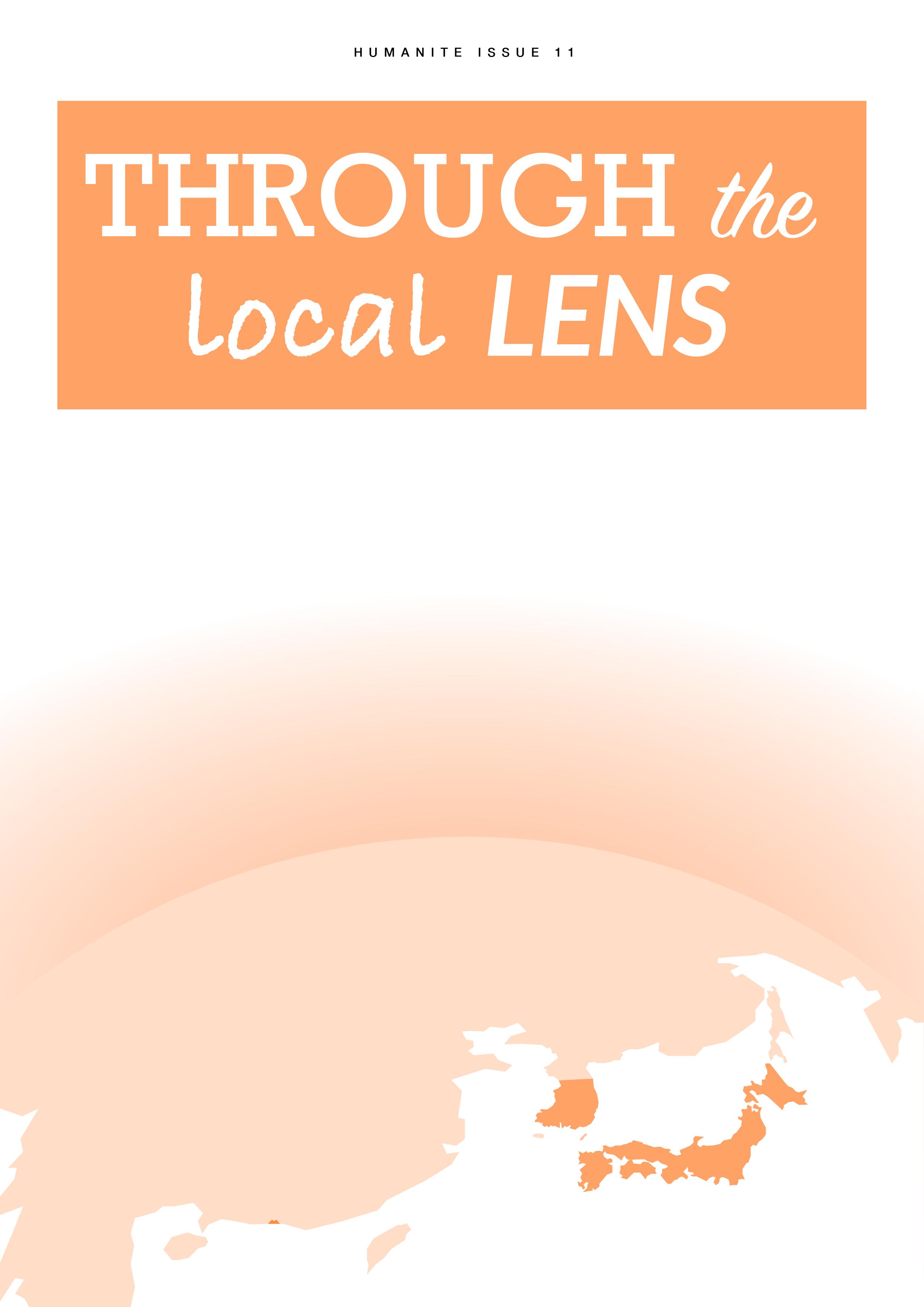
When I was presented with the prospect of expanding Humanité to other countries, I immediately endorsed the idea with the intention of widening the magazine’s outlook on societal issues with the work of more students from various walks-of-life. However, after publishing our last two issues about celebrity culture and science ethics and reflecting on our last two years after expanding internationally, I couldn’t help but ask myself, “have I really made use of the international aspect of our staff?” To this, I say that I definitely could have done better, especially in regards to highlighting the different communities that our staffers are a part of. On that account, the editorial board and I went back to the drawing board to create an issue that would emphasize the international element of Humanité; from this came this issue you’re reading right now, Through the Local Lens.
One of my biggest problems with the news and media we consume daily is that much of it is created by people who don’t know the full story, providing narrow-sighted or biased takes on issues they have no relation to. I attribute the radically divided and opinionated society we live in today to the overconsumption of such misleading information.
Hence, we had members from each country create work about an issue that they collectively felt was relevant to them and their community, and focused the editors’ feedback on bringing the members’ thoughts to fruition. In this issue Through the Local Lens, we take a deep dive into an issue specific to each country: the quality of life in South Korea, sexism in Japan, and Hong Kong’s relations with China. We hope you enjoy it!
President, Bryan Kim

While Japan is one of the most developed countries on Earth, its culture and laws regarding women remain outdated. While several amendments have been made in recent years helping to curb this problem, much work is still left in the fight for gender equality in Japan.
Historically, Japanese culture has expected women to marry, stop working, have children and take care of household duties. In the workplace, it is common for jobs to require women to wear makeup and to “look pretty” without anything similar applying to men. In general, there is often a “glass ceiling” that women hit, stopping them from being able to advance in their careers. This is an ever-pressing issue that must be addressed.
Students of ASIJ will share a range of articles and artworks depicting the experiences of women in Japan as they navigate through a sexist society. Changing the culture and laws is essential in creating a more equal society. By speaking on sexism in Japan from a more local point of view, ASIJ students hope to bring awareness and insight to this issue.











































#glassesban #メガネ禁止 #メガネ禁止 #glassesban HANA ITO
In 2019, the hashtag “#メガネ禁止” (“glassesban”) gained momentum on twitter as Japanese women voiced their discontent and their workplace experiences under sexist dress codes. The “glassesban” is only one of many rigid rules commonly imposed in the Japanese workplace, directed at women to regulate their physical appearances—such as to wear high heels, to wear makeup, to not dye their hair, and to not “gain weight.”
Earlier that year, the #KuToo movement similarly gained support on social media; women ridiculed workplace rules that they must wear high heeled shoes. (“The term #KuToo is a triple pun, playing on the Japanese words kutsu (shoes), kutsuu (pain), and the #MeToo movement.”) A petition was started to rid this rule, which collected 21,000 signatures. However, it gained little government recognition and was mocked by Japan’s health minister who claimed that such expectations are “necessary and appropriate.”
Such bans are a testament to the pervasive sex-based workplace discrimination in Japan and the ways in which working women are valued for/based on their physical attractiveness aside their skillsets.

#メガネ禁 #メガネ禁止#glassesban
BEAUTY STANDARDS IN JAPAN
Copy by Lila Kikuchi Layout by Eunice Rhee
1
Be polite, smile, and nod.
Always agree, do not object. Do not speak, let alone speak your mind, even at your own expense. If you must, make it quick, make it charming. Don’t be so greedy.
Serve others.
Don’t just be helpful. You must live to serve others. That is your purpose. Sacrifice your comfort, for others are of higher value. You are dispensable.
Preserve your purity.
Your innocence is your value. Seem unknowing, but be skilled when the time is right. Nobody wants something that’s already been used. Men enjoy the untainted.
Be mindful of your appearance.
Stay pale, thin, clean, and pretty. Don’t forget to wear sunscreen. Use light makeup, the paler the better. Starve for beauty, health is useless if nobody wants you. Embody femininity; pure, innocent, bright eyed, obedient.

2 3 4
Dont stand out.
5Blend in. You’re not special. Your ideas are neither useful nor original. You don’t have much to say anyways. Stop craving attention, but don’t forget, getting attention is all you’re good for.

Your purpose lies at home.
6Cook and clean, serve and wash. You exist for others—refer to rule 2—not yourself. Be grateful for what you have, being needed is a good thing. However, you are only needed at home, so that is where you belong. Take care of your husband, your children. You are at the bottom of the list. You are the last priority.
It’s the SAME

Fan service in anime has always been a controversial topic. Fan service is commonly shown in shonen (boy comics). There are arguments that it is sexist for fan service for the “male gaze” because it shows females as objects for marketing. However, the same happens and vice versa, therefore, sexist both ways. This piece shows how pointless it is to be mad at fan service if it happens both ways. What is sexist, however, is the poor writing that results in a character’s whole personality being dedicated to fan service, not fan service itself.
Katelyn Gumagay
SAME thing

Breathing Underwater
by: Sopheen Lee layout by: Mirabel Lee
Credit: Alexander Mahmoud


 Credit: Nuthawut Somsuk / IStockphoto
Credit: Nuthawut Somsuk / IStockphoto

Japan has always been known for its futuristic technology, but its views and policies regarding women in the workplace are largely outdated. Sexism in the workplace is an unmistakable issue in Japan. For decades, there has not been much change in helping fight the battle for women’s rights in the workplace. The deep divide between men and women in the workplace stems from two main points: the laws that perpetuate long-standing sexist policies and sexist ideals embedded in Japanese culture. Women struggle to climb the corporate ladder, and unless both the laws and culture in Japan begin to change, women will remain oppressed in the workplace. Laws preventing direct discrimination have been in place in Japan with the most recent amendment being from 2006; however, this is not without its loopholes. Employers in Japan often use height or weight restrictions to make women ineligi-
Sexism in the
By: Nate Wilson / layout:
ble for many jobs. While this is not direct discrimination, it effectively prevents women from entering and moving up in the workforce. The most common way women are discriminated against in the workplace revolves around policies regarding childbirth and pregnancy. Women are often dismissed, denied renewal of fixed-term contracts, and harassed due to pregnancy or childbirth.
In addition to being denied jobs based on sex, harassment in the workplace is a major problem in Japan. According to the Workplace Mental Health Research Commission, one of the leading causes of suicide among working individuals is workplace harassment. In Japan, there is an absence of laws that define and prohibit workplace harassment, making it difficult for employees to invoke legal provisions when seeking damages.
the Workplace
layout: Mirabel Lee
Social norms in Japan also play a major role in inhibiting women from pursuing their careers. In Japan, many still carry the notion that looking after family is for women. With women being solely responsible for cooking and cleaning on top of taking care of children, it is nearly impossible for them to have any time or energy to work. Additionally, women are often neglected when deciding on promotions or challenging responsibilities because of stereotypical gender roles and societal expectations. Japan’s societal views continue to hurt the country as so many talented and ambitious women are forced to stay home and do housework.
For the benefit of its own workforce, Japan must begin amending and creating more laws to further prevent workplace discrimination and harassment of women. Additionally, Japan must educate younger generations and attempt to change the cultural norms regarding women for equality to be achieved. Hopefully, Japan continues to amend laws and work towards a more equal society.


Hong Kong, a city fused with a variety of cultures, has had a rocky history with China since the Handover of Hong Kong in 1997. Since then, Hong Kong has been part of China’s “one country, two systems,” an agreement that promised Hong Kong unique privileges and autonomy compared to the rest of China. However, China has gradually been encroaching on Hong Kong’s rights in the past few years. They have increased mainland Chinese presence in the Hong Kong government and taken more control over the city using COVID-19 restric tions as an opportune excuse.

Hong Kong has not remained silent through all of this. Protests began in earnest in 2014 with the Umbrella Movement. In 2019, when the new legislature limited the power of the Hong Kong government, the entire city mobilized for the Anti-Extradition Law Amendment Bill Movement. Yet China has been equally relentless, sending more military personnel for each protest and passing the Hong Kong national security law in 2020, unfairly arresting hundreds of people.
Students of HKIS have produced a variety of articles to portray this complex relationship between Hong Kong and China. This included Hong Kong’s shifting musical culture, mass departure from Hong Kong, and China’s impact on Hong Kong during the COVID-19 pandemic. Students created these works in hope that they will bring awareness to the changes that China has brought on their lives in Hong Kong.
Hong Kong Mass Exodus
What This Means for the People of Hong Kong
Written by: Jaslyne Tam Layout by: Leo Sugino
At the closing assembly for the 2021-’22 school year, HKIS said goodbye to all of its departing teachers. e Principal called the name of each teacher, and they each stepped up to accept a parting gi and wait in line. But as the names kept piling up and the line of teachers kept growing longer, I realized how many people were leaving my school and city; it made me wonder. Was this speci c to HKIS, or were more people in Hong Kong leaving in general?
In just the rst half of 2022, Hong Kong’s population dropped by 110,000, almost twice the population loss from the previous year. is loss is apparent in both the school system and the workforce: the city’s labor force has dropped about six percent since 2018 to 3.75 million people (the lowest in nearly a decade) and more than 4,000 teachers have le their jobs in the past year, a ve-year high and a 70 percent spike from the year before. A h of Hong Kong’s international schools haven’t been able to hire enough teachers for this upcoming
year, even with bene ts and higher salaries o ered, which is a shocking turn for many of the city’s prestigious schools. However, teachers aren’t the only ones leaving, with 30,000 fewer students attending primary and secondary school in September of 2021 compared to the preceding October.
Many Hong Kongers leave for other cities famous for expatriates, such as Singapore. However, some expatriates return home, while native Hong Kongers apply for residency under new visa programs launched in Canada and the United Kingdom. e UK is one of the most popular destinations for those leaving, with their visa program set in place a er the 1997 handover back to China. e U.K. received 103,900 applications for the visa program in 2021, which entitles holders and their dependents to ve years of residence with a pathway to citizenship. A quick YouTube search will give you hundreds of vlogs of Hong Kong residents moving to the UK under this visa program.

Bloomberg
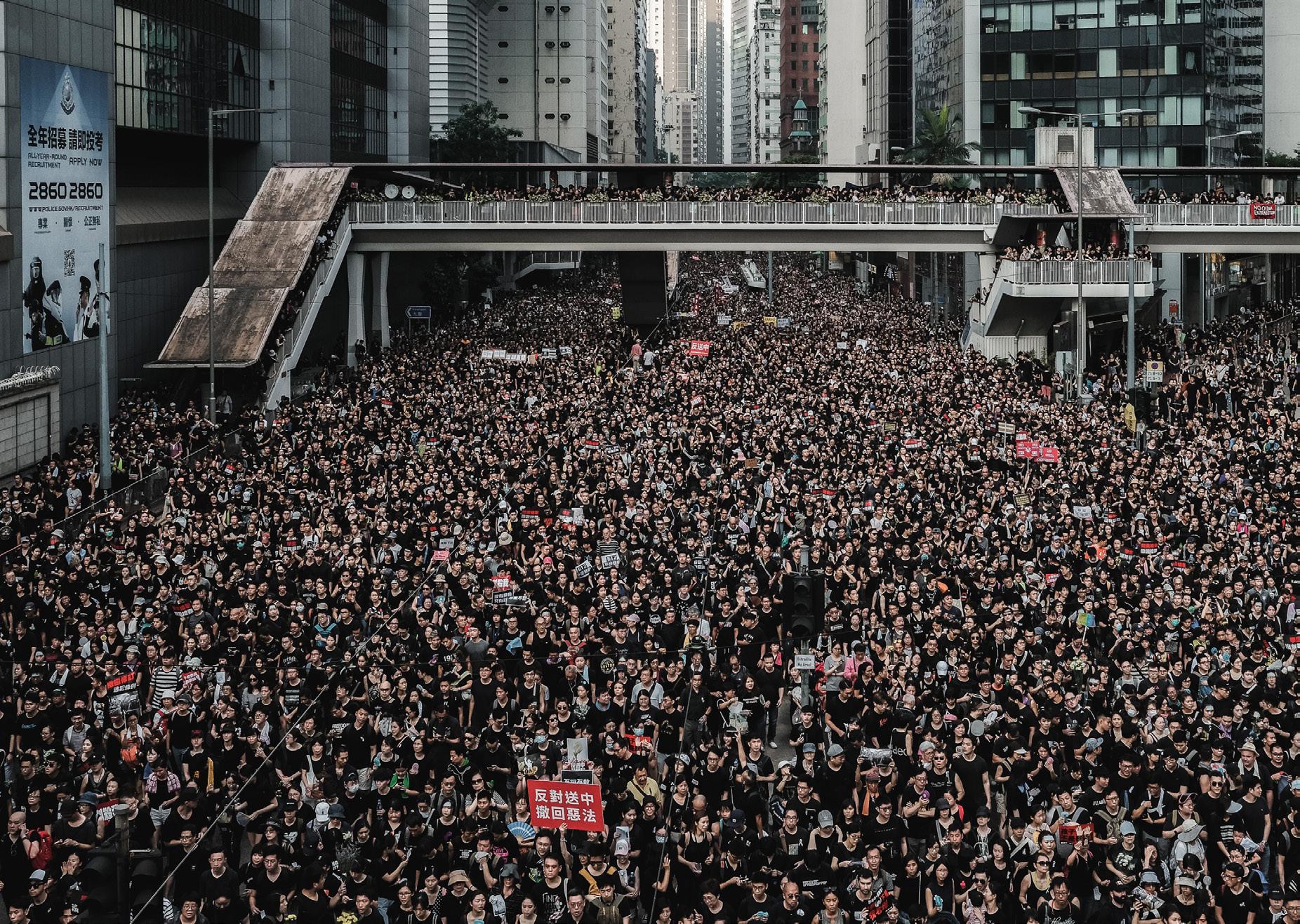
Airam Dato-on
Why Are People Going?
In
the wake of the social unrest in 2019, Hong Kong’s previous freedoms have been limited by the “National Security Law” under the Chinese government. Furthermore, Hong Kong’s strict COVID-19 policy has been the root of unease and frustration among both Hong Kong natives and expatriates, with many wondering when all of the lockdowns will nally end.
Many people who are leaving still consider Hong Kong home, but feel they are being forced to leave and that Hong Kong is no longer the country they grew up in. Especially with arrests and sometimes even imprisonments of students participating in the 2019 demonstrations, many felt that it was unsafe to live in Hong Kong, with one mother stating that they thought that “Hong Kong is not going to be under the rule of law… For the future of my son, I thought we had to leave.”

What Now?
For many expatriates, the government’s haphazard response to Omicron was the nal straw.
Seeing the government’s messy and o en illogical restrictions made them realize the extent of the ineptitude of the Hong Kong government. ey also said it made them realize how Hong Kong, a city they once loved, was becoming like other urban hubs in mainland China.
e future of Hong Kong is still hazy. However, the loss of expatriates, teachers, and workers in Hong Kong will
cause a general decline in Hong Kong’s pre-pandemic nancial power. e city will most likely never be able to recover from the pandemic rules, with the impact on the government, people, and infrastructure leaving a sizable dent. With many fearing that Hong Kong is turning into mainland China, it’s more than likely that the city will lose most of the Western freedoms it has been enjoying. Whether this is positive or negative is up to interpretation, but the impact on the city and its morale has already become evident.
zhang kaiyv

COVID-19 VACCINES EDUCATION REGULATIONS

AP EXAMS VIRTUAL CLASS
The Impact of COVID-19 Restrictions on Education in Hong Kong and Mainland China
By: Joshua Lee Layout by: Alice Lee
At the end of January 2020, several districts in China postponed all educational activities, and China’s Ministry of Education (MoE) urged schools and educational institutions to use online classes to limit congestion. Alarmingly, this is the first time online delivery has been approved on a large scale as part of formal education in China. In response to the call, most provinces, municipalities and autonomous regions in mainland China postponed the start of the spring semester and switched to online classes. From April 2020, face-to-face classes resumed sequentially from the final class of the grammar school (9th and 12th grade, the final class of the vocational school).
Since May 11, 2020, all regions of the mainland have resumed classes on secondary school campuses, representing approximately 107.79 million students (approximately 39% of China’s kindergarten student population) 26 students were allowed to return to the campuses of higher education institutions. , elementary and middle schools, and colleges) are back on campus. Students who physically attend on-campus classes are required to undergo temperature checks throughout the day, wear protective masks except in outdoor or low-risk environments, and eat separately. Some cities, such as Guangzhou and Shenyang, have asked all students, staff and faculty in Grade 9 and Grade 12 to undergo COVID-19 nucleic acid tests before returning to campus. It is understood that nucleic acid testing has also been introduced as a precautionary measure by some individual institutions, especially universities.
In Shanghai and Beijing, the government has initiated a complete lockdown, greatly negatively impacting students’ level of education. One of the greatest challenges that international students in China have faced this past year is not being able to take several college entrance exams as well as AP exams.
Due to the higher health risks, some cities have had to postpone plans to reopen schools until further notice. Education authorities in some cities, such as Jilin and Shulan, have been greatly affected by her COVID-19. During the COVID-19 pandemic, 20.7% and 7.2% of children aged 7 to 15 years reported post-traumatic stress disorder (PTSD) and depressive symptoms, respectively, due to the COVID-19 pandemic. PTSD and SMFQ-P scores are significantly higher in middle school and boarding school than in elementary and regular school students.
Recently, tens of thousands of pupils in Hong Kong returned to school for the start of the new academic year amid a government decision to tighten the vaccine thresholds for full-day in-person classes to combat a surge in Covid-19 cases. The return to classrooms this month came after a turbulent year, with students from many local schools forced to take some of their summer break in March, face-toface lessons restricted to half days and coronavirus tests required on a daily basis. The government had announced earlier this week it would require 90 per cent of students to be triple-vaccinated against Covid-19 from November if secondary schools wanted to hold full-day, in-person classes.
In general, the majority of respondents are satisfied with online education, but a significant proportion of students are still dissatisfied with this new form of learning. Authorities should streamline online education systems and take effective measures to manage the psychological impact of COVID-19 on children. This is because COVID-19 affects the global population and it remains uncertain when it will end.

The story of South Korea from the mid-1900s to the present day can be seen as a remarkable success. What began as a poor, war-torn, and dangerously foodinsecure country became a leading tech hub and flourishing economy. Hallyu— the Korean Wave—has been sweeping all corners of the world, bolstering its cultural presence.
But a closer look reveals that the country is far from perfect. The OECD index shows that although Korea exceeds the average in education, health, and civic engagement, it falls behind in social connections and life satisfaction. In a country known for such noteworthy and stable institutions, what exactly is degrading its quality of life?
This is the question SIS students aim to address in this issue. As international students, many times third culture kids, we are in a unique position; we are not the most experienced or knowledgable about the circumstances of the very land we live in. As such, we hope to use this issue not just to shed light on a diverse array of social issues underlying our country but also to better understand the complexities of our country ourselves.
Isolated Death in South Korea: The Tragedy of Indifference
by Jason Baek layout by June Jeong
Asof 2022, South Korea is classified as an “aged soci ety,” which is defined by the United Nations as a country having over 14% of its population aged 65 or above. Such a demographic in creases the risk of experiencing iso lated death. As the name suggests, an isolated death is characterized by dying unnoticed and without digni ty, which has drastically increased in numbers due to the aging popu lation combined with COVID-19. In fact, the supposed number of isolated deaths in 2021 by the Ministry of Health and Welfare totaled an appalling 953 people. Concerningly, experts anticipate this number to continue to increase as Korea experiences unprecedentedly low birth rates and ages by the day.
There are a few reasons death in isolation occurs so prevalently in South Korea. Firstly, the livelihood of aged people is heavily affected by their health complications such as illnesses and immobility. Especially

those who are not under the care of social workers possess limited means of connecting with the outside world. Furthermore, many live in poverty, having to survive with only the old age pension worth 300,000 won ($220) per month. This places them on a tight budget for procuring all basic necessities for living and con tributes to their unhappiness. Sec ondly, a myriad of aged populations in solitude result from a dysfunction al marriage or family. In the absence of their closest companions, human interaction becomes practically non existent, and those people become plagued with stress and loneliness that bring about increased risks of isolated death.
In the meantime, the South Ko rean government has endeavored to make meaningful changes on the issue of death in isolation. The Ministry of Health and Welfare has suggested various improvements and services for elderly welfare, es pecially in areas such as a basic pen-
sion, comprehensive care services, emergency notification services, a long-term care insurance system, dementia management support pol icies, employment support policies, and health-related policies. These programs collectively aid the senior citizens who live alone to sustain their lives monetarily, receive ed ucation, and obtain various health benefits ranging from vaccinations to implants.
Despite the proactive efforts by the government, the number of iso lated deaths is not showing any signs of decreasing; the magnitude of peo ple victimized by solitude far outweighs the amount of support avail able to them. This means individuals in the rest of the country should help contribute to the betterment of their living. In addition to govern-
ment policies, there are many ways we, as students, can send support to the elderly living in solitude. Simply participating in regular volunteer ing activities and becoming their talking companions may as well be the perfect cure to make up for the indifference of their neighbors and children. Spending time together or simply having a normal conversa tion may not sound like much, but are truly appreciated by the recipients. Alternatively, supplying small material necessities during regular visits, such as rice, ramen, or masks, can make their lives more convenient and manageable. As such, our small acts of kindness, when they accumulate, are capable of bringing about huge changes.

TOO MANY SEOULITES
by Paul Moon layout by June Jeong
South Korea is often referred to as an economic success, especially compared to its neighbor, North Korea. For example, despite there being no significant differences in the land area of the two nations, South Korea has a population of 51 million, which is almost exactly twice North Korea’s population. However, the large population is slowly becoming an issue, especially in the capital city of Seoul.
Seoul’s population is around 10 million people, harboring 20% of the entire population. Compared to the capitals of other Asian countries such as Tokyo, which has 11% of the population, and Beijing, which has 1% of the population, Seoul has a disproportionately large percentage of its country’s population.
This is made even worse because the land area of Seoul is approximately 0.6% of the total land area of Korea, causing population density to be very high. As a result, overpopulation has caused issues like high living costs, high competition among youths, and high rates of home-
lessness.
Firstly, the living costs in Korea, specifically housing costs, are rising at an alarming rate. In 2017, the average apartment price in Seoul was approximately 500 million KRW, whereas, in 2022, it is close to a billion KRW. Along with poor govern ment handling and excessive liquidity of the market, overpopulation is causing an uncontrollable increase in housing prices. Because so much of the population is concentrated in and around Seoul, hous ing costs in Seoul and other large metropolitan areas are high. Younger generations that are looking to buy houses, therefore, look in adjacent provinces such as Gyeonggi province where the prices are more attainable.

This problem is paradoxical with Korea’s other major issue: low birth rates. South Korea recently beat its own world record for the lowest birth rate out of any country with an actively shrinking population at 0.92 children per woman. The average age of the population is therefore

increasing, currently being 43 years. The trend of home ownership correlates with age, with nearly 80% of people aged 70 owning a home, compared to less than 10% for people under 30.
Low birth rates might seem like it cre ates lower competition rates for younger people seeking jobs and education, but this is yet another issue affected by overpopulation. There is currently a record high unemployment rate for people aged 15-29. This is because there are only two stable job options available for youths in Korea: becoming a government worker or a worker for a conglomerate.
Conglomerates control South Korea’s economy, with the top five largest conglomerates collectively constituting 56% of the nation’s GDP. This is what causes so few job opportunities because these conglomerates create monopolies that squeeze out competition, limiting the number of open positions on the market.



The only stable option is a government job and this notion is solidified in children even from middle school, with one in four middle schoolers stating that they aspire to become a government worker. Every
year, over 200,000 people apply for a government position, and the overall acceptance rate is 2.4%, lower than the ac ceptance rate for prestigious universities such as Stanford or Harvard.
What then can be done about this is sue? Well, for starters, the housing crisis can be addressed with widespread upzoning, the practice of converting single-house areas to land with tall apartments to accommodate more residents. This would be an expensive government endeavor, and would not be received positively by current residents in and around the area as housing prices would deflate, but it would be a way to address the is sue.
Another way to reduce overpopulation in Seoul is to create more economic op portunities elsewhere in Korea. If there were more stable and well-paying job opportunities in other parts of the country other than Seoul, then the problem would eventually be resolved. This might seem idealistic and impossible, and it might be so. However, if no solutions are tried and the overpopulation continues to get worse, the situation might become too severe to address.
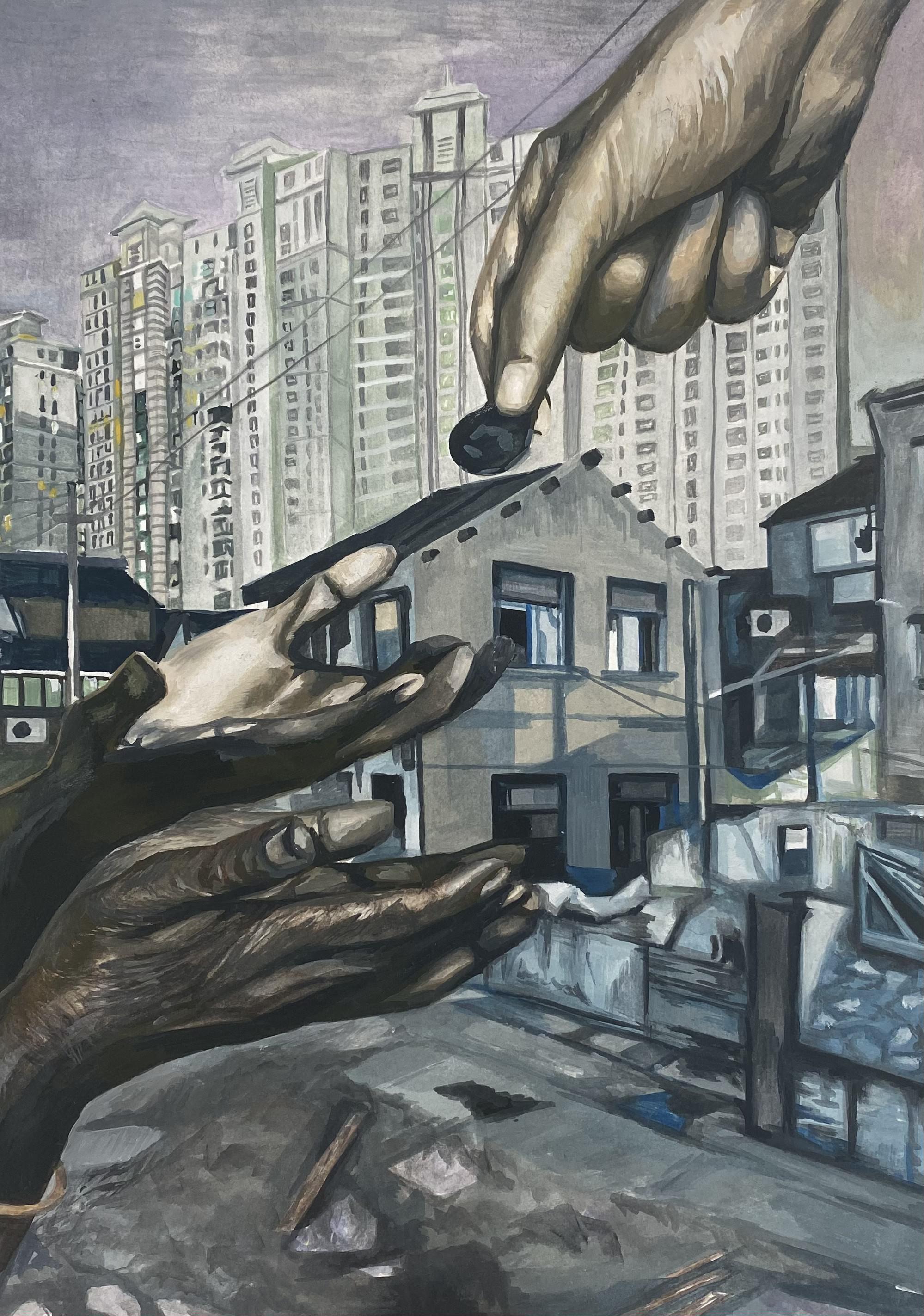
Celine Yang
Poverty of Old Age
Elderly poverty is a rising problem around the world, especially in Korea. This is due to numerous problems such as retirement benefits. This painting was made using gouache paint and it represents an elderly person receiving money from someone living a less impoverished life. This contrast is depicted in the front of the painting where there is a harsh living environment filled with old houses while in the behind there are more developed buildings.
The Increasing Inaccessibility of South Korea’s Labor Market

 by: Jason Lee layout by: Sophia Park
by: Jason Lee layout by: Sophia Park
Tomany, South Korea seems like the pinnacle of modern urban society; the bumbling streets appear to foster a deeply rich and diverse community perfect for an eventful young adult life. However, the high-rising skyscrapers also serve as a monument of unscalable magnitude for up-and-coming workers in the Korean market, who are struggling to get stable jobs. Just how inaccessible has the South Korean job market become, and what problems could it create?
For one, South Korea’s job market has become so inaccessible in the status quo because of an extremely rigid system that makes it difficult for employers to fire full-time, “established” employees. Once a worker has been contractually signed to a full-time position, it is nearly impossible for an employer to get rid of them as long as they aren’t clearly detrimental to the company. As a result, along with the silver tsunami (overabundance of old people) in South Korea’s labor force, young people are not
prioritized in hiring. Since 2012, the average age of South Korean retirees has increased from 55 to 62. This is harmful to up-and-coming workers, as younger employees are usually delegated to temporary, lower-paying positions. Even worse, these young workers have few legitimate courses of action to solve this problem. Speaking up for change has only made these workers more of a liability in the eyes of employers, thus further lowering their chances of getting hired to more stable jobs.
As one might imagine, this stratification in the job market has extremely adverse effects. Notably, the rigid age hierarchy of the Korean job market kills diversity, as it allows older people to remain in their positions that younger workers thus cannot fulfill. This not only limits fresh perspectives in corporations but also hurts younger people’s consumption patterns: as they are incapable of getting higher-paying jobs, they are more likely to save their money for the long term
and not spend as much. This hurts the economy overall and can lead to economic depressions, while also potentially exacerbating the already wide socioeconomic disparity between old and young in South Korea. Further, it can worsen the tension and political stratification between age groups, which has already manifested itself in the recent presidential election that was almost a 50/50 split between conservative (older) people and more liberal (younger) people.
The situation is dire, so what courses of action should or have we taken to mitigate this issue? The consensus is that the system that heavily favors older workers must be overturned for one that creates more opportunities for younger people to create a footing in the job
market. However, previous attempts at creating such a system have either failed to meaningfully take off, not garnered enough support, or even been counterproductive at solving the problems like in the example of strikes led by young workers discussed earlier.
In the end, South Korea is ways away from making an equal system that presents equal opportunities for all. However, with the right steps, South Korea’s status as one of the best global economies would become cemented.
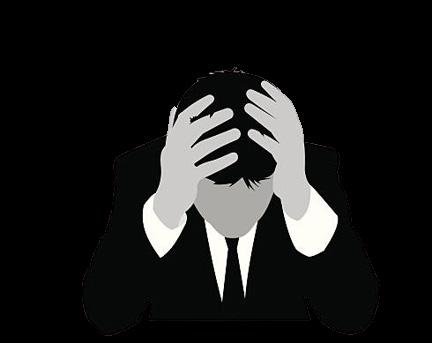

e Education Systems and Its Impacts on Korean Students’ Quality of Life
In Korea, Seoul National University has great name value and prominently asserts itself as one of the top Korean schools. In the Korean population, only 4% of the students have the ability to apply to this school, and only 15% of stu dents are accepted. is means only 0.6% of the Korean population get into the top school, thus creating a competitive atmosphere among students. Since Asian countries consider education to be more valuable than to other regions, students must go through many more hardships than the international average. Due to this, academic pressure is far greater than necessary and students o en feel overly stressed.
swan
Written by Austin Chung Layout by Andrew Ham
A 6-3-3-4 year system summarizes the education path of Korea: 6 years in ele mentary school, 3 years in middle school, 3 years in high school, and 4 years in college. Every citizen in Korea is expected to follow this path, as public education is available to everyone. However, the great est impact of the education system is not based on the years one spends learning, but the competitive atmosphere the stu dents must live through. Strict education policies force students to go through rigorous training for personal gain. Par ents, despite students already facing great pressure, want their children to achieve larger success than other children, thus
creating an uncomfortable competitive environment between students that o en lead to disputes.
ough the parents’ hard work may re ect positively on their children, this isn’t the likely outcome. Most students are expected to follow either a strictly math ematical or literary side then commit most of their high school lives keeping high GPA, taking tests, or doing activities that may raise their chance of entering a renowned university. Because of this, students rely on their parents on import ant decisions during their adolescent years, an important time when people learn to become independent. Beomjun, a freshmen high school student in Seoul International School, states that he’ll live a boring life a er graduating, since he’ll study in college or university, then work until he is able to retire. His answer high lights the e ect of education on Korean students, as he nds himself unable to recognize what he enjoys since he’s given a de nitive path he must follow. Most students in the school also share similar sentiments as Korean students are usually too busy to invest time and money into hobbies or enjoyable activities. Since this problem robs students of their dreams, it’s de nitely a problem that requires attention. However, putting legal measures as a solution is ill advised, as the
main problem doesn’t lie in the law, but the custom. erefore, a gradual change to parenting is the key to rekindling students’ lives. Instead of choosing a de nitive path for the student, simply giving advice and words of encouragement is enough for the student’s education career. Trying to put a round peg into a square hole doesn’t work, so forcing students to follow their parents’ footsteps while ignoring the students’ wishes also yields the same outcome. Allowing the student to study the subjects they enjoy not only ensures success, but the student’s happi ness as well.

This piece was made digitally and expresses the stereotypes student. Because of the stereotype of “smart asian much. However, Korean students have the highest number studying. This expectation VS reality is what this piece

Korea is very different from
Minji
stereotypes of the quality of life of a normal Korean kids”, many people may think that they don’t study number of hours spent in their houses or study cafes piece intended to show. The quality of life for students in from what people think it is.

Minji Kim
The Harsh Reality of Korean Work Hours
Korea has always had a reputation for hard-working children and adults. Growing up in a competitive environment, only to face more strict deadlines and rigid rules in their compa nies, most citizens seem unable to escape this vicious cycle. However, when does it go too far? Korean workplaces, more o en than not, have stringent work hours for their employees. It seems that even a er the quality improvements were put into place, overtime and normal working conditions are still uncompromisingly determined.
swan
Compared to other economically developed countries such as Germany, Denmark, and the United Kingdom, South Korea has a less exible working system, according to a report by the Federation of Korean Industries. is report suggested that companies should provide their workers with the option to work more when they need to, and take longer breaks in return.
At the moment, employees rarely ever get a say or have the chance to argue about the in exibility of their work hours. For example, the majority of workers work for eight hours a day with a maximum of 12 hours of overtime per week with a guaranteed break hour for every eight hours of work. is is an issue due to the lack of freedom and, arguably, too short of a break time compared to hours of work. According to Globalization Partners, vacation time is also very limited, legally requiring all companies with full-time paid employees to provide een days of paid vacation annually a er a year of service with the company. Additionally, every two years therea er gives the worker an extra day of vacation up to a total limit of 25.
Other economically developed countries, such as Kuwait and France, exceed these numbers. For example, employees in Kuwait are entitled to the highest number of paid leave per year. e total amount, including 13 public holidays, gives work ers 43 days of paid leave. Not only this, but a er two years of consistent work, workers are given an extra 21 days to themselves. Workers in France are rstly given a standard of 36 vacation days but some who have exceeded expectations or have stored their vacation days may even reach a total of 9.5 weeks of paid leave in a year, though this is

very rare.
A more relaxed system would most likely have workers being able to work more productively. An example of this is Germany where, in contrast to Korea, employees have the choice to save their overtime hours in an account and use them when vacation or rest is much needed. is makes it easier for workers to balance work and home life, something that Korean citizens can not prioritize.


According to the Organization for Economic Cooperation and Development, or OECD, around 21% of female Korean workers spend over 50 hours per week at their jobs. Compared to the average of 8% instating this habit globally, this number is daunting. Even the statutory right to request more exible working hours are not available to most company workers unless one is nursing a child younger than 12 months old. is discourages many wishing to start a family from fully committing themselves to a working environment.
So, how can an employer combat this issue? Many wish for a more lenient and lengthier mater nal or parental leave. Promoting greater work exibility would top the wish list for a better work system, as only 8.4% of Koreans are able to institute exible working hours. Workplace policies might consider developing ways for their workers to adjustable starting and nishing times and spread work hours across a longer time span such as weeks or months. Online or teleworking options can also be e ective ways to help employees balance work and home life and be more productive overall.
In conclusion, overworking has put most Korean citizens through incredible amounts of stress, from earlier life to employment. If these harsh conditions continue, many employees will be barred from the opportunity of greater work and life balance. Putting measures in place to prevent strict rules and longer work hours would give Korea a great step toward a happier country for its citizens.
Written by Grace Lee Layout by Andrew Ham
Problems and Solutions to
By: Peter Kim Layout by: Alice Lee
Healthcare
in South Korea is one of the best in the world: service is quick, payments are generally cheap, and the bureaucracy is simple enough to work with the people. However, this does not mean that the system is flawless. Simply put, the flaws of the Korean healthcare system lie in the details.



Firstly, the healthcare tax. South Korea has a special tax that all citizens must pay, which means that healthcare for all is mandatory, whether one desires government-provided healthcare or not. Private healthcare is an option as well, but the government does not allow it to replace the public healthcare system and allow citizens to get out of paying the healthcare tax. The healthcare tax itself is around 7-8% of a person’s income on top
of regular tax. Some may say to reduce the amount of coverage Korean healthcare gives to reduce the tax; however, that is seldom an option. South Korean public healthcare covers a maximum of just 60% of medical costs, far lower than healthcare in countries like Canada, which covers a complete 100% of costs. In fact, this is partially the reason why most Koreans, 77% of the population, opt to buy private insurance, seeing that private healthcare can surpass the 60% limit.
The solution to this issue is simple: reduce the healthcare tax by increasing other taxes. Currently, the Korean healthcare system is funded through three primary ways: healthcare tax, government subsidies, and tobacco surcharges. The national government currently pays about 14% for public healthcare
to Korean Healthcare


surcharges currently pay about 6%, and taxpayers through the healthcare tax pay a whopping 80% of the public healthcare funds. The burden of paying for public healthcare does not need to be necessary: by increasing the taxation rate for tobacco surcharges, the problem of funding can be alleviated while reducing cases of lung and throat cancer in the long term. With this same philosophy, the government can add surcharges to other goods that are social vices in Korea, such as heavy alcohol. Considering how much of the Korean population drinks alcohol, even a minor surcharge on alcohol can greatly aid in funding healthcare without forcing taxpayers to pay higher prices mandatorily. Gambling, another social vice, can also be taxed, although this would apply only to foreigner-accommodating casi-

nos because gambling is illegal in Korea.
In the end, what is needed in the Korean social welfare system, not just specifically healthcare, is the realization that tax-andspend policies suffer massive effects of diminishing returns when it comes to making these programs better. Eventually, as is almost the case in Korea, healthcare will simply be too expensive in taxes for little gained benefit for all. If the government feels the need to gather more funds for programs, it would be better for them to diversify their tax collection, not simply burdening the people with income taxes.

Korea’s Flooding
It was a dark and stormy night…
On August 8-9, 2022, South Korea expe rienced the heaviest rainfall in over a century, an event that destroyed numerous buildings and infrastructure and led to the deaths of 13 civilians.
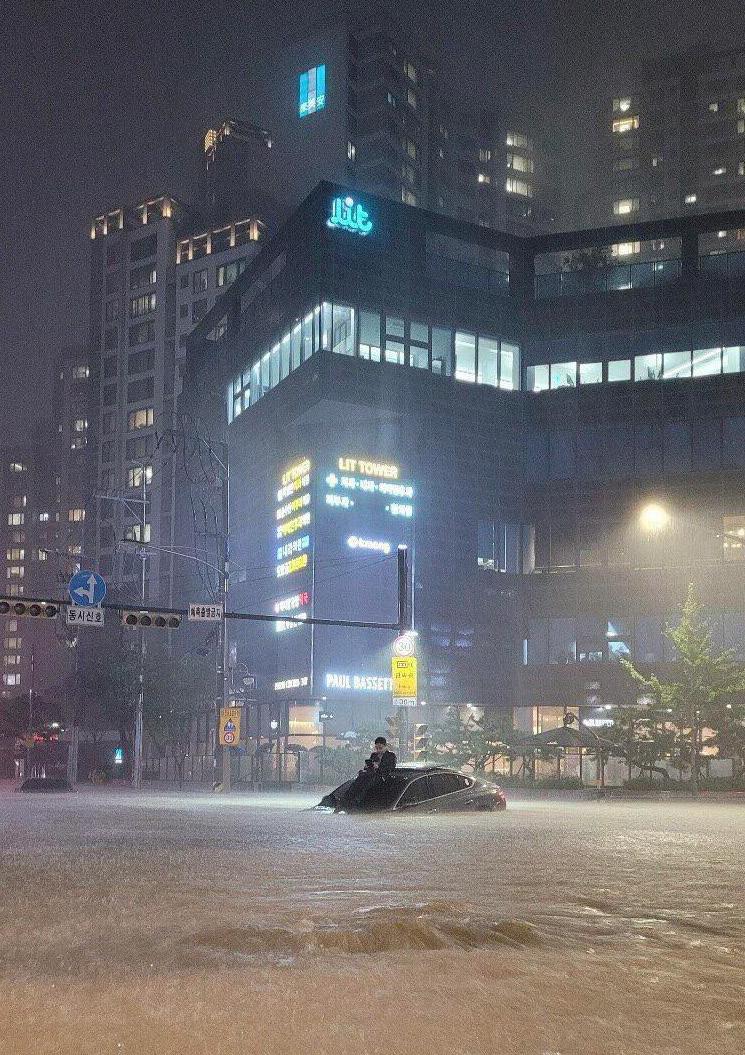
Cramped and crowded urban areas such as Seoul’s Gangnam and Dongjak districts were flooded with rainwater, with the latter receiving 422 millimeters of rain over the course of 26 hours. The concrete-covered streets forced water into the lowest areas of the city, killing several individuals in un derground parking lots and semi-basement homes.
Though such urban areas in South Ko rea are often considered some of the most well-developed, affluent neighborhoods in the nation, the torrential downpour of rain during the monsoon season has revealed the nation’s deepest environmental, economic, and social flaws.
For instance, the Korean government came under harsh criticism for lack of aid given to lower income citizens that commonly resid ed in semi-basement homes. Though sim ilarly devastating floods in 2010 and 2011 had encouraged the Korean government to attempt to remove semi-basement homes as a major part of urban infrastructure, over 200,000 such homes remain in downtown Seoul, where the recent flooding had the greatest impact. The recent housing crisis and the rapidly rising cost of living in South Korea have only exacerbated the issue, with greater numbers of middle-income families having difficulty finding affordable housing.
And finally, this overlooked problem has reared its ugly head. According to a Korean news report, a family of three lost their lives during the flooding by drowning in their semi-basement home after local authorities had failed to reach them in time after they had called for help.
The government’s inactivity in ensuring the safety of lower-income citizens during emergency situations and the starkly con trasting experiences between the wealthy and the poor in South Korea demonstrate the issue of rampant financial inequality that has only worsened in the past years.
Overall, the Korean government was com pletely unprepared for such a crisis, leading to numerous unnecessary deaths as well as the damaging of essential urban infra structures, such as subways and buildings. While President Yoon has claimed that the nation will be phasing out of semi-basement homes, several other problems such as deep ly-rooted economic inequality, the extreme urbanization of South Korea, as well as gov ernment ineptitude are likely at fault for this crisis.
Many have also criticized the current conservative administration for their lack of commitment to preserving the environ ment, citing the increasingly common oc currences of extreme weather events. This included not only the flooding, but also the record-high summer temperatures that citi zens claim serve as evidence that the govern ment must increase its efforts to stay carbon neutral. Despite this, President Yoon’s ener gy policies will only continue to lessen the government’s attempts at decreasing carbon emissions and reduce the amount of funding for renewable energy sources.

Leadership at the local level was also heav ily scrutinized, with Seoul Mayor Oh Sehoon facing severe public backlash on social media after uploading pictures of himself
having a large meal while areas of Seoul were being flooded.

Though the uncovering of numerous flaws in the Korean government, infrastructure, and economy through this environmental disaster is greatly concerning, it may give rise to urgently needed change. Mayor Oh stated a day after the incident that the Seoul city government would now completely phase out semi-basement apartments, with remaining homes being converted into non-residential use buildings within the next 20 years and current tenants receiving housing vouchers. Furthermore, President Yoon’s already-low approval rating was fur ther lowered to a record-breaking 20 percent after the flooding, which may perhaps urge the conservative politician to rethink his harmful environmental policies. For now, many hope that this disaster will have a pos itive long term effect in inducing improve ments to the quality of life in South Korea, particularly for lower-income households.
As several regions around the world in cluding Europe, America, and East Asia all seem to be facing environmental crises such as droughts and floods, it has become more evident than ever that changes must be made to environmental policy. It is crucial that South Korea, as well as the global com munity as a whole, should not only become better prepared for future climate disasters, but also pass climate change legislation to prevent these disasters from becoming more prevalent in the future.
by: Junseo Lee layout by: Sophia Park
BOARD
PRESIDENT
V. PRESIDENT
WRITING ED.
WRITING ED. PROD. MANAG.
LAYOUT ED. LAYOUT ED.
LAYOUT ED.
PUBLIC RELA.
Bryan Kim
Aimee Choi
Woojune Kim
Rachel Yoon
Jihoon Kim
Andrew Ham June Jeong
Eunice Rhee
Alice Lee
BRANCH LEAD
JAPAN JAPAN
HONG KONG HONG KONG
Samuel Hong Nate Wilson
Eric Cho Joshua Lee
WRITERS
KOREA
KOREA KOREA KOREA
KOREA KOREA
Peter Kim
Lauren Kim
Jason Baek
Junseo Lee
Paul Moon Sahngwon Lee
KOREA KOREA
KOREA
KOREA
KOREA
HONG KONG
HONG KONG
JAPAN
Alex Cho
Jason Lee
Rachel Cho
Austin Chung
Grace Lee
Ariel Yu
Jaslyne Tam
Sopheen Lee
LAYOUT
KOREA KOREA
JAPAN
JAPAN
Sophia Park
Ellen Ryu
Mirabel Lee
Leo Sugino
ART
JAPAN
JAPAN
KOREA KOREA
Hana Ito
Katelyn Gumagay
Minji Kim
Celine Yang




















































 Credit: Nuthawut Somsuk / IStockphoto
Credit: Nuthawut Somsuk / IStockphoto
















 by: Jason Lee layout by: Sophia Park
by: Jason Lee layout by: Sophia Park












